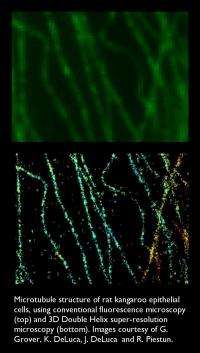Novel U. of Colorado 3D super-resolution imaging technology to be developed by Boulder company

Double Helix LLC of Boulder and the University of Colorado have completed an exclusive option agreement to allow Double Helix to develop a novel technique for 3D super-resolution imaging.
The technology was developed by CU-Boulder Professor Rafael Piestun of the electrical and computer engineering department. Super-resolution -- techniques to enhance the resolution of an imaging system beyond the limitations set by the diffraction of light -- is key to the development of next-generation microscopes and other optical instruments. The Double Helix optical technology combines 3D optics and a unique signal post-processing technique used for quality improvement in image processing.
The optical technology offers a major opportunity to provide multifunctional 3D super-resolution imaging capability to thousands of cellular, molecular biology and biophysics laboratories in the United States and around the world. The Double Helix technology platform is applicable to a variety of scientific, industrial and consumer applications, including microscopy, metrology and computational digital photography, said Piestun.
Piestun also is the director of Computational Optical Sensing and Imaging, a National Science Foundation-funded program for education and research training.
"We are looking forward to bringing this leading-edge technology to the market, initially in microscopy and later to more markets including metrology and digital optics, a stronghold of the Boulder entrepreneurial community," said Double Helix founding partner Leslie Kimerling.
"We are excited to see this company launch with our broad fundamental patents," said Ted Weverka, a licensing manager at the CU Technology Transfer Office. "The cost savings and superior technology will give Double Helix a strong lead."
Provided by University of Colorado at Boulder















